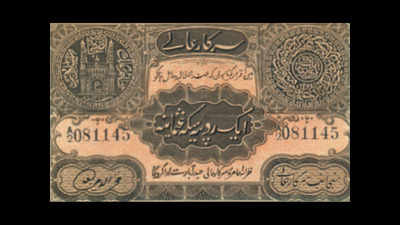- News
- City News
- Hyderabad News
- India’s first demonetisation, a 100 years ago in Hyderabad
Trending
This story is from February 1, 2020
India’s first demonetisation, a 100 years ago in Hyderabad
The year 2020 marks the centenary of India's first demonetisation of paper currency. It was in 1920 that the Nizam government in Hyderabad had withdrawn Rupee 1 paper currency from circulation. The Nizam had introduced Rs 10 and Rs 100 paper currency in 1918 and Rupee 1 in 1919 as there was severe shortage of metal particularly silver in view of the World War I.

Hyderabad Rupee 1 (obverse) withdrawn in 1920 as people did not accept it
HYDERABAD: The year 2020 marks the centenary of India's first demonetisation of paper currency. It was in 1920 that the Nizam government in Hyderabad had withdrawn Rupee 1 paper currency from circulation. The Nizam had introduced Rs 10 and Rs 100 paper currency in 1918 and Rupee 1 in 1919 as there was severe shortage of metal particularly silver in view of the World War I.
There were, however, no takers for the Rupee 1 note as it had no intrinsic value though backed by a government guarantee, while Rupee 1 silver coin, which was in circulation then, had intrinsic value as it had silver in weight.
Moreover, the Rupee 1 note was printed in black. People saw the colour as inauspicious and thus refused to accept it. This forced the Nizam to withdraw the note within one year of its introduction, heralding India's first demonetisation.

In 1861, the British government became the sole issuer of paper currency and all private banks, which had their own banknotes, were directed to withdraw them. But the first legal tender (Re 1) issued by a government (Hyderabad state) was withdrawn in 1920, thus officially the first demonetisation drive.
The Nizam issued Re 1 and Rs 5 banknotes in 1919. Later, he issued Rs 1,000 banknote in 1926. The withdrawn currency was kept in the royal treasury and destroyed in March 1939. However, about 8,500 notes remained with the public. Waterlow, which had the contract to print money, had printed two crore notes. During transit, 608 notes were stolen in Bombay. The government destroyed 20.92 lakh notes which were in circulation. Another 1,78,98,642 notes, which were not issued, were also destroyed, Amarbir said, adding that while five notes were kept as souvenirs in the mint, 245 were preserved in the central treasury of the Nizam.
He said soon after the Nizam government destroyed Re 1 notes, World War II began in September 1939, once again creating shortage of metal, and the need to reintroduce Re 1 note arose. Security press at Nasik turned down the request to print Re 1notes citing circumstances beyond its control. This led to the birth of ‘made in Hyderabad’ Re 1 as the new notes were printed at government press in Malakpet.
There were, however, no takers for the Rupee 1 note as it had no intrinsic value though backed by a government guarantee, while Rupee 1 silver coin, which was in circulation then, had intrinsic value as it had silver in weight.
Moreover, the Rupee 1 note was printed in black. People saw the colour as inauspicious and thus refused to accept it. This forced the Nizam to withdraw the note within one year of its introduction, heralding India's first demonetisation.

According to senior banker and expert numismatist Amarbir Singh, the British government had conferred on the princely state of Hyderabad the right to mint its own coins. "During World War I, due to extreme shortage of metal, especially silver, Hyderabad was finding it difficult to meet the demand of money markets. The British government suggested that Hyderabad improve the situation by issuing paper currency. This resulted in the Hyderabad Currency Act 1917/1918 which got Nizam VII, Mir Osman Ali Khan's assent on June 4, 1918," he said.
In 1861, the British government became the sole issuer of paper currency and all private banks, which had their own banknotes, were directed to withdraw them. But the first legal tender (Re 1) issued by a government (Hyderabad state) was withdrawn in 1920, thus officially the first demonetisation drive.
The Nizam issued Re 1 and Rs 5 banknotes in 1919. Later, he issued Rs 1,000 banknote in 1926. The withdrawn currency was kept in the royal treasury and destroyed in March 1939. However, about 8,500 notes remained with the public. Waterlow, which had the contract to print money, had printed two crore notes. During transit, 608 notes were stolen in Bombay. The government destroyed 20.92 lakh notes which were in circulation. Another 1,78,98,642 notes, which were not issued, were also destroyed, Amarbir said, adding that while five notes were kept as souvenirs in the mint, 245 were preserved in the central treasury of the Nizam.
He said soon after the Nizam government destroyed Re 1 notes, World War II began in September 1939, once again creating shortage of metal, and the need to reintroduce Re 1 note arose. Security press at Nasik turned down the request to print Re 1notes citing circumstances beyond its control. This led to the birth of ‘made in Hyderabad’ Re 1 as the new notes were printed at government press in Malakpet.
End of Article
FOLLOW US ON SOCIAL MEDIA










